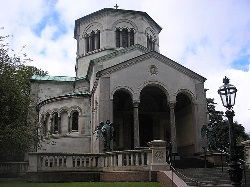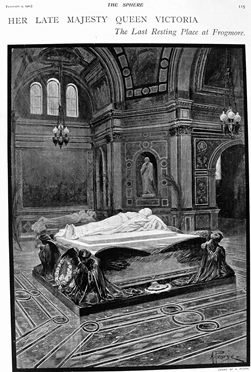Geologist and science writer Nina Morgan discovers how a Scottish stone mason changed the face of Victorian cemeteries
The mid-19th Century saw a proliferation of granite memorials in cemeteries throughout England. This partly reflects improvements in transport and the growth of the rail network; but it was invention of a steam-powered machine to dress and polish granite by Aberdeen-based stonemason, Alexander MacDonald [1794 – 1860], that seriously fed the fashion for polished granite memorials.
The son of a crofter, MacDonald founded a firm of monumental sculptors and granite quarriers in around 1820 at 83 Queen Street, Aberdeen, at a time when the whole granite trade was said to consist of ‘three journeymen masons, two or three apprentices and a dog’.
MacDonald's enterprise flourished. By the end of the 19th Century the company was employing upwards of 100 men and boys (but no dogs!) to meet the growing demand. The quality of the firm's granite obelisks and monuments earned it medals at the Great Exhibition of 1851 and prizes at major international exhibitions in Paris (1867, 1878), Philadelphia (1876) and Melbourne (1880).
Royal customers
 This string of honours must have brought the firm to the attention Queen Victoria and Prince Albert, who had begun considering designs for their own mausoleum while still in their twenties. When Albert died on 14 December 1861, Victoria initiated the construction of the Royal Mausoleum at Frogmore in Windsor Great Park (picture, left) just four days after his death. MacDonalds was commissioned to construct the massive double granite sarcophagus destined to hold the coffins of both Albert and, eventually, Victoria herself.
This string of honours must have brought the firm to the attention Queen Victoria and Prince Albert, who had begun considering designs for their own mausoleum while still in their twenties. When Albert died on 14 December 1861, Victoria initiated the construction of the Royal Mausoleum at Frogmore in Windsor Great Park (picture, left) just four days after his death. MacDonalds was commissioned to construct the massive double granite sarcophagus destined to hold the coffins of both Albert and, eventually, Victoria herself.
The sarcophagus, composed of dark grey Cairngall granite from near Peterhead in Aberdeenshire, a granite intruded around 470 million years ago and associated with the Caledonian Orogeny, is made out of the largest block of flawless wrought granite ever quarried in Britain. Extracting such a large block posed a serious challenge. The first three attempts failed when flaws were discovered underneath the stones after they had been detached. The block finally chosen weighed 30 tons, and 12 Clydesdale horses were needed to pull it from the quarry to the MacDonald works. Once there, the rough granite was shaped, hollowed out to receive two coffins, and then polished. The completed structure, resting on polished granite blocks, weighed in at nine tons (picture, right). The lid alone weighed five tons.
Mis-measurents
 But somewhere along the line, someone got the measurements wrong. The night before Victoria's funeral in 1901 it was discovered that the Queen's coffin was too deep to fit into the space provided to receive it. According to a report published on 1 June 1901 in the New Zealand newspaper Marlborough Express:
But somewhere along the line, someone got the measurements wrong. The night before Victoria's funeral in 1901 it was discovered that the Queen's coffin was too deep to fit into the space provided to receive it. According to a report published on 1 June 1901 in the New Zealand newspaper Marlborough Express:
"The discovery created great consternation among the Court officials and employees at Windsor. Orders were at once give to have an attempt made to deepen the sarcophagus, and stonehewers were occupied at this work in relays all night. Not being accustomed to work on such a hard substance as granite ... little progress was made."
Instead, the paper reports, slips of wood six inches deep and painted to represent granite were used as temporary supports to support the sarcophagus lid. Victoria's successor, King Edward VII, hastily ordered heavy mouldings of Cairngall granite to be shaped and polished – presumably by MacDonalds – and fixed onto the sarcophagus, which was then permanently sealed.
Measuring mishaps notwithstanding, Albert, who had a special interest in applying science and art to the manufacturing industry, would surely have been proud to lie beneath such a magnificent example of a stonemason's technology. What a pity that laser measuring devices hadn't yet been invented!
Acknowledgements
Sources for this vignette include: Alexander MacDonald (2194 – 1860) – Stonemason by Ron Knee, available for download from www.fownc.org/pdf/newsletter73.pdf; an article about Alexander MacDonald & Co available from www.glasgowsculpture.com/pg_biography.php?sub=macdonald_a-co; The website www.paperspast.natlib.govt.nz; Wikipedia entries for Frogmore Mausoleum, Prince Albert and Queen Victoria; and an article titled: Windsor: The glory of a grave affair by Anne Campbell Dixon, which appeared in the Daily Telegraph on 17 May 2003. Information about Cairngall granite is taken from Ruth Siddall's Urban geology in London Guide, No 15: Conduit Street, available for download from www.ucl.ac.uk/~ucfbrxs/Homepage/UrbanGeology.htm.
* Nina Morgan is a geologist and science writer based near Oxford. Her latest book, The Geology of Oxford Gravestones, is available via www.gravestonegeology.uk